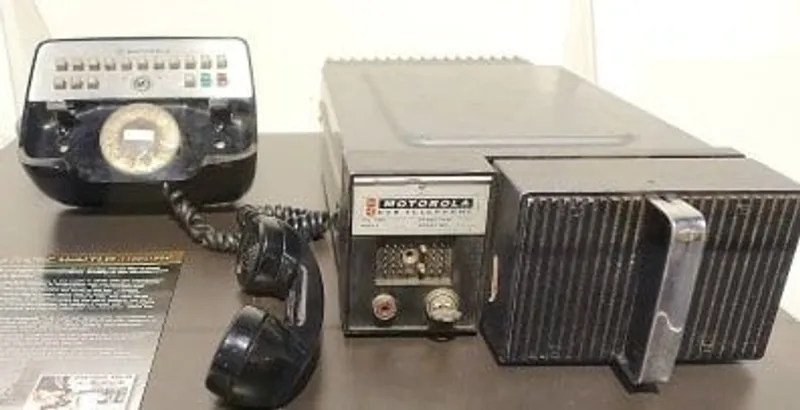Telnyx
A Brief History of Telephony
Here's a brief history of telephony gallery. Can you imagine a time without the telephone? We surely couldn't!

Try to imagine a time without communications technology or even a telephone - I sure can’t! While we’ve come a long way from smoke signals and snail mail, it’s always good to look back and see how we got to where we are today. So we welcome you to a brief history of telephony, where we’ll explore where we started and where we're headed.
In the Beginning
We should all know that it all started with Alexander Graham Bell who is credited with patenting the first practical telephone on March 7, 1876. Three days later, he transmitted the phrase "Mr. Watson, come here! I want to see you!" in the world’s first telephone call. We wonder if he realized then how his invention would completely revolutionize the way the world communicates forever.
It took almost 40 years from Bell's first historic call until the first coast-coast call was completed as the small job of rolling out the telephone network got underway. The telephone network started in New York City in 1885, and by 1892, it had reached Chicago. The long distance line headed west throughout the years, and it reached Denver by 1911. On January 25, 1915, Alexander Graham Bell officially inaugurated the launch of the AT&T transcontinental phone service in New York as he called Thomas Watson in San Francisco.
Into the 20th Century
The 20th Century saw many considerable advancements in the world of communications. The first free-standing rotary phone was introduced in 1919. The candlestick was initially the most popular style of telephone. The Model 302 by Western Electric and Bell System was introduced in 1937, which featured the boxed design that became more popular in the middle of the 20th century.
Although one-way transatlantic telephone communications happened over a decade earlier, it really wasn't until January 1927 when the first official two-way commercial transatlantic telephone call was made via radio. Transatlantic communication was seen as an important step in connecting businesses. You can listen to the conversation between Sir Evelyn P. Murray in London and W.S. Gifford in New York below, courtesy of the History Channel:
Mid-century Technology
By the mid-1900’s the idea of a more mobile telephony service started to creep it’s way into popular culture. Mobile service for car telephones became official in June 1946 in St. Louis, Missouri thanks to Bell Labs. Shortly after, the idea of a hand-held mobile phone peeped into science fiction and pop culture. In the 1950’s and 1960’s, TV shows depicted such phones as spy gadgets hidden in common items like - you guessed it - a shoe. At the time, mobile phones were still pretty huge, with car phones weighing as much as 80 pounds! The Motorola TLD-1100 from 1964 is a good example of a typical 'mobile' phone from back in the day:

Around the same time, in September 1956, the first submarine transatlantic telephone cable system, the Transatlantic No. 1 (TAT-1) was launched. This was an iconic feat as it signaled the true era of modern communication around the world. According to BT, the project was inaugurated by the Chairman of AT&T in New York who called the Postmaster General in London, England.
That '70s Phone
Fast-forwarding to the 70’s and the first mobile phone call. It was made on April 4th 1973 between Motorola executive Martin Cooper and Joel Engel of Bell Labs. Cooper used a Motorola DynaTAC prototype to make the call but it would be over a decade before the new mobile phone was released to the public.
In 1976 a Japanese inventor, Kazuo Hashimoto invented one of the most used and appreciated features of any phone system, even to this day: Caller ID. The patent- US 4,242,539- was eventually licensed to most telecom companies around the world but, like the mobile phone, the public again had to wait a decade for the technology to be released. Market trials ran in 1984 but true commercial deployment didn't happen until 1987.
Perhaps the biggest breakthrough of the 1970’s in terms of telephony was the successful test of Network Voice Protocol (NVP) by Danny Cohen at the Information Sciences Institute (ISI), University of Southern California in December 1973. This was one of the earliest iterations of Voice over Internet Protocol technology. According to ISI, NVP was used to send speech over packetized communications networks on the ARPANET, the first wide-area packet-switching network.
Into the Future
After successfully being tested 10 years prior, the Motorola DynaTAC 8000X mobile phone was finally ready for the spotlight. Nicknamed "The Brick," the phone was officially unveiled in 1983 with a $3,995 price tag. The image below is of Martin Cooper, the Motorola executive who made it all possible, with the DynaTAC in 2007.
While most of the world was preoccupied by the newest mobile technology, installation of new networks was also underway. The Transatlantic No. 8 (TAT-8) was completed on December 14, 1988. This was a revolutionary moment for communications around the world as it was the first transatlantic fiber optic cable system ever laid. The technology was capable of handling 40,000 simultaneous phone calls, a huge increase when compared to its predecessor- the TAT-7- which was only able to handle 4,000.
Age of Disruption
VoIP
VocalTec changed the game in 1995 when it released the InternetPhone - pioneering the VoIP revolution. This is considered as the first commercial VoIP service. The fees charged by VocalTec for international and long distance calls were a fraction of the price being charged by telephone companies at the time.
Not long after in 1996, Session Initiation Protocol (SIP) was created by Mark Handley, Henning Schulzrinne, Eve Schooler and Jonathan Rosenberg. It was initially designed as a communications protocol to signal and control multimedia communication sessions. These days, SIP is most commonly used for internet telephony like voice and video calls.
The Start of Smartphones
Released in August 1996, the Nokia 9000 Communicator was a game changer. Considered to be one of the first commercial smartphones, the Communicator provided all the functionality of a desktop, from email to web surfing, all in the palm of your hand. Many believe it paved the way for development of Blackberry’s- and later iPhone’s- which many people could not dream of living without in today’s world.
From the Past to the Present
A hyper-connected world
It’s no surprise that the world of telephony and communications has benefited from the advancements made in technology in the early 2000’s. This has led to significant growth in the wireless market, as more and more people need to be connected 24/7/365. This can be seen clearly in the change in the number of wireless subscribers in the US over a 30-year period.
There were about 340,000 wireless subscribers in the US in 1985. By 2015, that number had grown to 300,000,000, 1000x greater, according to CTIA. Data on global mobile subscription by GSMA intelligence puts the total number at 4.9 billion in 2017 and there is no signs of these growth trajectories slowing down.
In the early 2000’s Skype took what VocalTec started with VoIP and ran with it. Launched on August 29, 2003, Skype’s software would revolutionize the way people communicated through their computers, using voice and video to give a profound new experience to its users all over the world. Perhaps most importantly, the service was free. This development connected more people across countries than ever before, and paved the way for the video calling features built into so many products and applications that we use today.
Another major evolution of the 21st century to-date has been the accelerated growth of Unified Communications. Unified Communications generally describes the integration of a number of communications tools- such as voice, email, instant messaging and video conferencing- into a single application or interface. Adoption of UC is on the rise, with 44% of businesses having either started the process of deploying or already deployed a UC solution in 2015, according to XO.
What's in Store for Telephony?
It’s fair to assume that VoIP-based technologies and services will continue to disrupt telecommunications, grabbing a bigger slice of the pie. Zion Research predicts the industry to be worth above $140 billion by 2021, a huge jump from its $83 billion market value in 2015.
Looking past the next couple of years, it’s likely that ‘The Internet of Things’ will also see hyper-growth as companies work on developing products that will easily integrate with legacy systems and workflows. Gartner forecasts that 20.8 billion connected things will be in use around the world by 2020.
"Communications is going to be one of the big ones," said former Oculus CEO Brendan Iribe on the future of VR. Imagine being with a friend or loved one - who's on the other side of the globe - in a virtual world and communicating with them like they're next to you. Facebook demoed this last year:
Much of the last century has been defined by the development and rapid adoption of new telephony and communication technologies, and it’s showing no signs of slowing down.
Share on Social
Sign up for emails of our latest articles and news
Related articles
